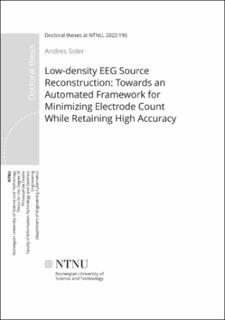| dc.description.abstract | In this thesis, multiple approaches for electroencephalographic (EEG) source reconstruction using low-density electrode counts are introduced. Source reconstruction provides valuable information about the location and time-courses of the source activity in the brain cortical areas. For such estimation, the use of a high number of electrodes has been proven to provide the most accurate estimation of the underlying brain activity. However, high-density EEG (hdEEG) is not generalized for most EEG applications, thus neither is the use of the source estimated activity. Although source reconstruction can provide spatially segregated time courses and relevant information about the dynamical interaction of brain regions, most EEG applications still rely on analysis and feature extraction from the electrode space.
This thesis provides a link between source reconstruction and low-density EEG (ldEEG) systems. It presents a set of rigorous methodologies designed to identify EEG electrodes according to their contribution to localization accuracy and minimizes their numbers through optimization routines. hdEEG is taken as the reference for source imaging when mapping a particular brain activity or the activity of a region of interest (ROI). Previous works have studied the influence of the spatial sampling (number of electrodes) in brain generalized source reconstruction, where the positions of the electrodes were selected to attempt covering the entire head/scalp. In contrast, this work presents approaches to identify and select electrode locations based on their relevance to capture the underlying activity or their contribution to obtain accurate reconstructions of the activity of interest, while using the lowest number of electrodes possible.
Simplifying the number of electrodes while obtaining detailed information of the source activity can be beneficial for multiple EEG applications. It can serve to improve portability, enabling recordings to be taken in more natural environments outside the lab; to design easy-to-use devices that can monitor the source activity for different neuroparadigms/applications; to reduce the accessibility boundaries to non-traditional EEG users; and to expand the research scope of EEG based source activity reconstruction. For these purposes, three methodologies are introduced in this work. The first study consists of constraining the estimation to a set of frequency modes extracted in the electrode space prior to source activity reconstruction. The method of Multivariate Empirical Mode Decomposition (MEMD) was applied to extract the frequency modes of the underlying source activity in ldEEG electrode configuration.
A second study consists of the use of spatial constraints, in which the estimation is conferred to a section of the brain, using a priori knowledge of the general location of the source activity. For this, a technique based on partial models of the brain is combined with relevance-based electrode selection using a Q-alpha (𝑄 − 𝛼) method for relevance feature selection, in order to determine the most relevant electrode positions that can be used to map a region of interest. In addition, when considering the full brain model, relevance selection is compared in multiple electrode scenarios to compare the accuracy of the reduced number of electrodes with denser systems. A third study consists of electrode selection based on its contribution to localization accuracy, and a methodology combining evolutionary optimization and source reconstruction is introduced. The nondominated sorting genetic algorithm II (NSGA-II) is applied to identify optimal combinations of electrodes that offer the best source reconstruction accuracy.
The results show the feasibility of identifying reduced electrode counts that offer an equal or better reconstruction quality. In most cases, electrode counts between 6 and 12 electrodes are found to maintain the hdEEG accuracy of electrode counts with 128 electrodes. This represents an important reduction in the number of electrodes while maintaining high accuracy; demonstrating that a set of a few electrodes can be used to estimate the source activity in a particular scenario. The frameworks established here can serve to evaluate to what extent current systems with reduced electrode counts can be used for source reconstruction, and to identify the optimal electrode positions for different neuro-paradigms and applications. | en_US |
